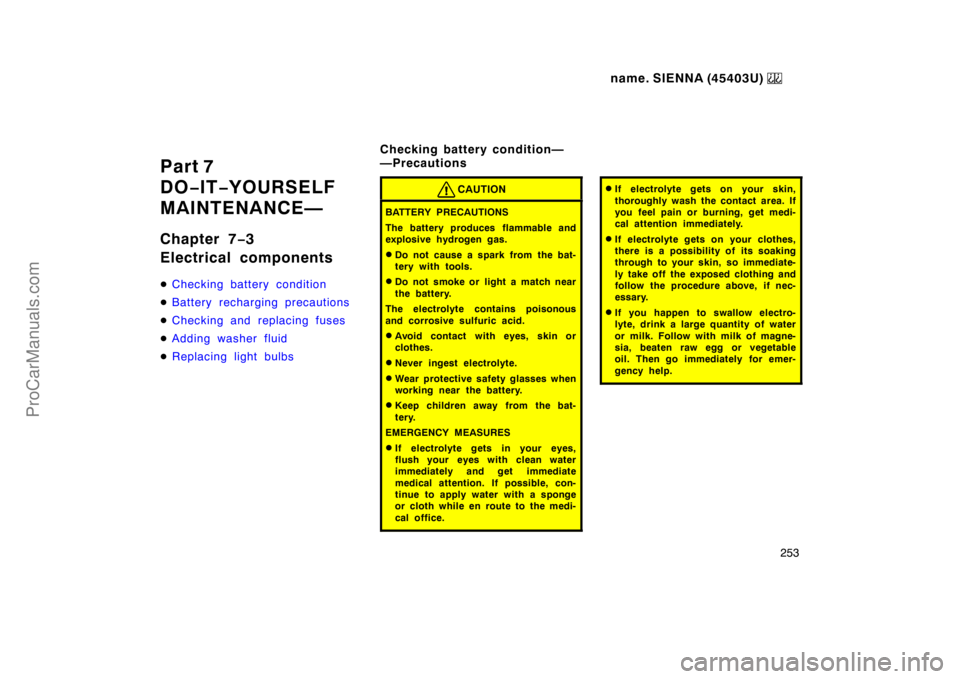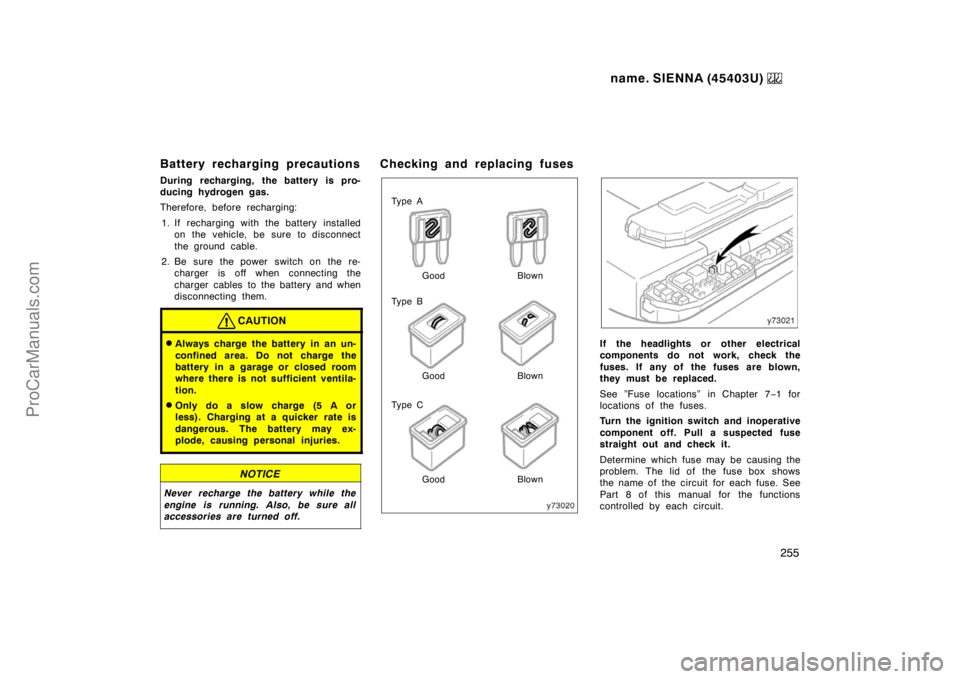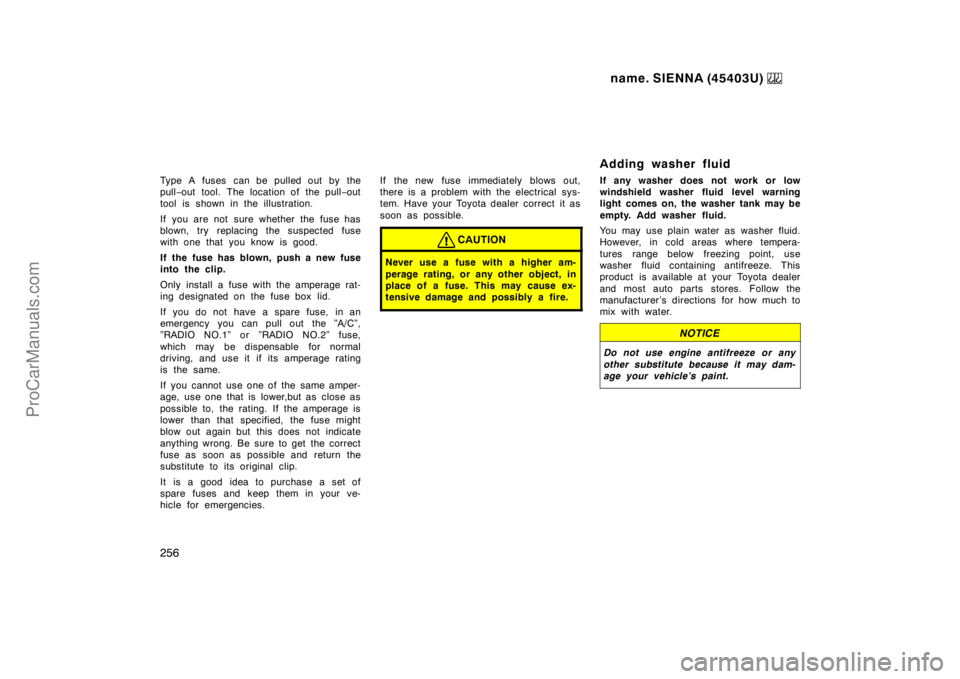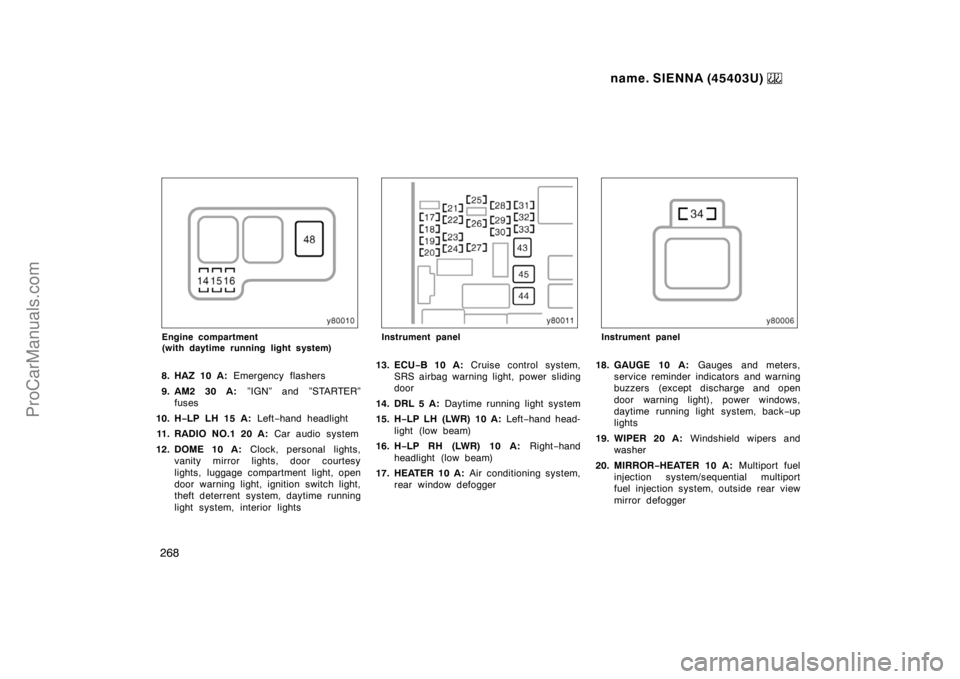Page 239 of 272
name. SIENNA (45403U)
239
Fuse locations
Spare fuses
Without daytime running light system
With daytime running light system
ProCarManuals.com
Page 242 of 272

name. SIENNA (45403U)
242
Parts and tools
Here is a list of parts and tools you will
need on performing do−it−yourself mainte-
nance. Remember all Toyota parts are de-
signed in metric sizes, so your tools must
be metric.
Checking the engine oil level
Parts (if level is low):
�Engine oil API grade SJ, ”Energy−
Conserving” or ILSAC multigrade hav-
ing viscosity proper for your climate
Tools:
�Rag or paper towel
�Funnel (only for adding oil)
Checking the engine coolant level
Parts (if level is low):
�”Toyota Long Life Coolant” or equiva-
lent
See Chapter 7−2 for details about cool-
ant type selection.
�Demineralized or distilled water
Tools:
�Funnel (only for adding coolant)Checking brake fluid
Parts (if level is low):
�SAE J1703 or FMVSS No. 116 DOT 3
brake fluid
Tools:
�Rag or paper towel
�Funnel (only for adding fluid)
Checking power steering fluid
Parts (if level is low):
�Automatic transmission fluid
DEXRON®II or III
Tools:
�Rag or paper towel
�Funnel (only for adding fluid)
Checking battery condition
Tools:
�Warm water
�Baking soda
�Grease
�Conventional wrench (for terminal
clamp bolts)Checking and replacing fuses
Parts (if replacement is necessary):
�Genuine Toyota fuse or equivalent with
same amperage rating as original
Adding washer fluid
Parts:
�Water
�Washer fluid containing antifreeze (for
winter use)
Tools:
�Funnel
Replacing light bulbs
Parts:
�Bulb with same number and wattage
rating as original (See charts in
”Replacing light bulbs” in Chapter 7−3.)
Tools:
�Screwdriver
�Wrench
ProCarManuals.com
Page 253 of 272

name. SIENNA (45403U)
253
Part 7
DO−IT−YOURSELF
MAINTENANCE—
Chapter 7−3
Electrical components
�Checking battery condition
�Battery recharging precautions
�Checking and replacing fuses
�Adding washer fluid
�Replacing light bulbs
CAUTION
BATTERY PRECAUTIONS
The battery produces flammable and
explosive hydrogen gas.
�Do not cause a spark from the bat-
tery with tools.
�Do not smoke or light a match near
the battery.
The electrolyte contains poisonous
and corrosive sulfuric acid.
�Avoid contact with eyes, skin or
clothes.
�Never ingest electrolyte.
�Wear protective safety glasses when
working near the battery.
�Keep children away from the bat-
tery.
EMERGENCY MEASURES
�If electrolyte gets in your eyes,
flush your eyes with clean water
immediately and get immediate
medical attention. If possible, con-
tinue to apply water with a sponge
or cloth while en route to the medi-
cal office.
�If electrolyte gets on your skin,
thoroughly wash the contact area. If
you feel pain or burning, get medi-
cal attention immediately.
�If electrolyte gets on your clothes,
there is a possibility of its soaking
through to your skin, so immediate-
ly take off the exposed clothing and
follow the procedure above, if nec-
essary.
�If you happen to swallow electro-
lyte, drink a large quantity of water
or milk. Follow with milk of magne-
sia, beaten raw egg or vegetable
oil. Then go immediately for emer-
gency help.
Checking battery condition—
—Precautions
ProCarManuals.com
Page 255 of 272

name. SIENNA (45403U)
255
Battery recharging precautions
During recharging, the battery is pro-
ducing hydrogen gas.
Therefore, before recharging:
1. If recharging with the battery installed
on the vehicle, be sure to disconnect
the ground cable.
2. Be sure the power switch on the re-
charger is off when connecting the
charger cables to the battery and when
disconnecting them.
CAUTION
�Always charge the battery in an un-
confined area. Do not charge the
battery in a garage or closed room
where there is not sufficient ventila-
tion.
�Only do a slow charge (5 A or
less). Charging at a quicker rate is
dangerous. The battery may ex-
plode, causing personal injuries.
NOTICE
Never recharge the battery while the
engine is running. Also, be sure all
accessories are turned off.
Checking and replacing fuses
Good Ty p e A
Ty p e B
Ty p e CGood Good Blown
Blown
Blown
If the headlights or other electrical
components do not work, check the
fuses. If any of the fuses are blown,
they must be replaced.
See ”Fuse locations” in Chapter 7−1 for
locations of the fuses.
Turn the ignition switch and inoperative
component off. Pull a suspected fuse
straight out and check it.
Determine which fuse may be causing the
problem. The lid of the fuse box shows
the name of the circuit for each fuse. See
Part 8 of this manual for the functions
controlled by each circuit.
ProCarManuals.com
Page 256 of 272

name. SIENNA (45403U)
256
Type A fuses can be pulled out by the
pull−out tool. The location of the pull−out
tool is shown in the illustration.
If you are not sure whether the fuse has
blown, try replacing the suspected fuse
with one that you know is good.
If the fuse has blown, push a new fuse
into the clip.
Only install a fuse with the amperage rat-
ing designated on the fuse box lid.
If you do not have a spare fuse, in an
emergency you can pull out the ”A/C”,
”RADIO NO.1” or ”RADIO NO.2” fuse,
which may be dispensable for normal
driving, and use it if its amperage rating
is the same.
If you cannot use one of the same amper-
age, use one that is lower,but as close as
possible to, the rating. If the amperage is
lower than that specified, the fuse might
blow out again but this does not indicate
anything wrong. Be sure to get the correct
fuse as soon as possible and return the
substitute to its original clip.
It is a good idea to purchase a set of
spare fuses and keep them in your ve-
hicle for emergencies.If the new fuse immediately blows out,
there is a problem with the electrical sys-
tem. Have your Toyota dealer correct it as
soon as possible.
CAUTION
Never use a fuse with a higher am-
perage rating, or any other object, in
place of a fuse. This may cause ex-
tensive damage and possibly a fire.
Adding washer fluid
If any washer does not work or low
windshield washer fluid level warning
light comes on, the washer tank may be
empty. Add washer fluid.
You may use plain water as washer fluid.
However, in cold areas where tempera-
tures range below freezing point, use
washer fluid containing antifreeze. This
product is available at your Toyota dealer
and most auto parts stores. Follow the
manufacturer ’s directions for how much to
mix with water.
NOTICE
Do not use engine antifreeze or any
other substitute because it may dam-
age your vehicle’s paint.
ProCarManuals.com
Page 263 of 272
name. SIENNA (45403U)
263
Part 8
SPECIFICATIONS
�Dimensions and weight
�Engine
�Fuel
�Service specifications
�Ti r es
�Fuses
Dimensions and weight
Overall width
2900 (114.2) Overall height
1610 (63.4) Wheelbase
Front tread 1565 (61.6)
Rear tread
526 (1160)
∗
2
∗
1: Unladen vehicle∗
2: Wagon∗
3: Van with rear seat∗
4: Van without rear seatOverall length
Vehicle capacity weight
(occupants + luggage)mm (in.)
kg (lb.)4915 (193.5)
1865 (73.4)
1710 (67.3)
∗
1
574 (1265)∗
3
612 (1350)∗
4
mm (in.)
mm (in.)
mm (in.)
mm (in.)
mm (in.)
ProCarManuals.com
Page 267 of 272
name. SIENNA (45403U)
267
Fuses
Engine compartment
(with towing package)Engine compartment
(without towing package)
Engine compartment
(without daytime running light system)
Fuses (type A)
1. SPARE 10 A: Spare fuse
2. SPARE 15 A: Spare fuse
3. SPARE 30 A: Spare fuse
4. ALT−S 5 A: Charging system
5. H−LP RH 15 A: Right−hand headlight
6. EFI 15 A: Multiport fuel injection sys-
tem/sequential multiport fuel injection
system
7. HORN 10 A: Horn, theft deterrent sys-
tem
ProCarManuals.com
Page 268 of 272

name. SIENNA (45403U)
268
Engine compartment
(with daytime running light system)
8. HAZ 10 A: Emergency flashers
9. AM2 30 A: ”IGN” and ”STARTER”
fuses
10. H−LP LH 15 A: Left−hand headlight
11. RADIO NO.1 20 A: Car audio system
12. DOME 10 A: Clock, personal lights,
vanity mirror lights, door courtesy
lights, luggage compartment light, open
door warning light, ignition switch light,
theft deterrent system, daytime running
light system, interior lights
Instrument panel
13. ECU−B 10 A: Cruise control system,
SRS airbag warning light, power sliding
door
14. DRL 5 A: Daytime running light system
15. H−LP LH (LWR) 10 A: Left−hand head-
light (low beam)
16. H−LP RH (LWR) 10 A: Right−hand
headlight (low beam)
17. HEATER 10 A: Air conditioning system,
rear window defogger
Instrument panel
18. GAUGE 10 A: Gauges and meters,
service reminder indicators and warning
buzzers (except discharge and open
door warning light), power windows,
daytime running light system, back−up
lights
19. WIPER 20 A: Windshield wipers and
washer
20. MIRROR−HEATER 10 A: Multiport fuel
injection system/sequential multiport
fuel injection system, outside rear view
mirror defogger
ProCarManuals.com